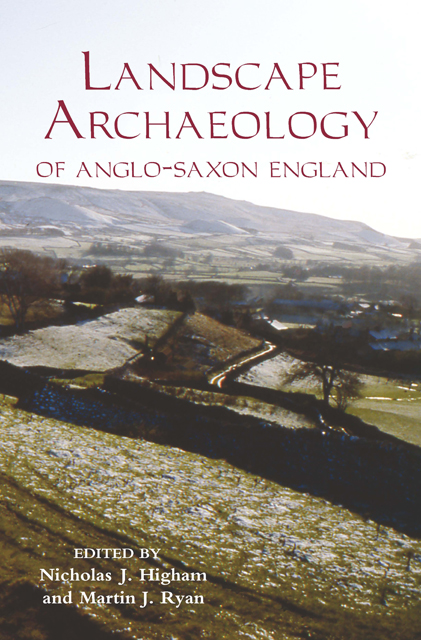Book contents
- Frontmatter
- Contents
- List of Illustrations
- Contributors
- Acknowledgements
- Abbreviations
- 1 The Landscape Archaeology of Anglo-Saxon England: An Introduction
- 2 Barriers to Knowledge: Coppicing and Landscape Usage in the Anglo-Saxon Economy
- 3 Landscape Change during the ‘Long Eighth Century’ in Southern England
- 4 Population Ecology and Multiple Estate Formation: The Evidence from Eastern Kent
- 5 Exploring Black Holes: Recent Investigations in Currently Occupied Rural Settlements in Eastern England
- 6 Medieval Field Systems and Settlement Nucleation: Common or Separate Origins?
- 7 The Environmental Contexts of Anglo-Saxon Settlement
- 8 Calendar Illustration in Anglo-Saxon England: Realities and Fictions of the Anglo-Saxon Landscape
- 9 The Anglo-Saxon Plough: A Detail of the Wheels
- 10 ‘In the Sweat of thy Brow Shalt thou eat Bread’: Cereals and Cereal Production in the Anglo-Saxon Landscape
- 11 The Early Christian Landscape of East Anglia
- 12 The Landscape and Economy of the Anglo-Saxon Coast: New Archaeological Evidence
- Index
6 - Medieval Field Systems and Settlement Nucleation: Common or Separate Origins?
Published online by Cambridge University Press: 16 February 2023
- Frontmatter
- Contents
- List of Illustrations
- Contributors
- Acknowledgements
- Abbreviations
- 1 The Landscape Archaeology of Anglo-Saxon England: An Introduction
- 2 Barriers to Knowledge: Coppicing and Landscape Usage in the Anglo-Saxon Economy
- 3 Landscape Change during the ‘Long Eighth Century’ in Southern England
- 4 Population Ecology and Multiple Estate Formation: The Evidence from Eastern Kent
- 5 Exploring Black Holes: Recent Investigations in Currently Occupied Rural Settlements in Eastern England
- 6 Medieval Field Systems and Settlement Nucleation: Common or Separate Origins?
- 7 The Environmental Contexts of Anglo-Saxon Settlement
- 8 Calendar Illustration in Anglo-Saxon England: Realities and Fictions of the Anglo-Saxon Landscape
- 9 The Anglo-Saxon Plough: A Detail of the Wheels
- 10 ‘In the Sweat of thy Brow Shalt thou eat Bread’: Cereals and Cereal Production in the Anglo-Saxon Landscape
- 11 The Early Christian Landscape of East Anglia
- 12 The Landscape and Economy of the Anglo-Saxon Coast: New Archaeological Evidence
- Index
Summary
For more than a century, historians and archaeologists have explained the emergence in the Anglo-Saxon period of open and common fields and nucleated settlement as the contemporary products of a new, co-ordinated approach by Germanic migrants and/or their descendants to improving the efficiency of agricultural production. Protagonists have argued about whether the social relationships underpinning this change were proto-manorial or an expression of community decision-making, but have not disagreed that these features were linked or that they emerged in the post-Roman period.
‘Nucleated’ settlement is concentrated in just one place in a township, rather than dispersed in scattered farms and hamlets. Such settlements might originate in a single place, or be polyfocal; and they might contain planned elements or have informal origins and additions, or a combination of both. By the Middle Ages, nucleations tended to be concentrated in the ‘central province’, a distribution lying across England roughly along a line from the Isle of Wight in the south-west to Northumberland in the north-east (Fig. 6.1). ‘Open fields’ – that is, sub-divided fields whose internal divisions were not sufficient to hamper access across them – were found throughout medieval England (Fig. 6.2). Across central southern England, however, a specialised subset of open fields, often characterised as ‘common’ or ‘Midland’, had developed by about 1300, identified by a rigorous regularity of layout, tenure, and cropping (Fig. 6.3).
While there have been attempts over the past forty years to narrow down the period in which both nucleation and field systems were introduced, what has not been at issue has been the conviction that both shared a common origin. This paper explores the contribution to this latter thesis of a growing body of archaeological evidence.
Historiography
The earliest known observations of differences between the ‘planned’ landscape of predominantly nucleated villages and regular common-field systems in ‘Midland’ England, and the ‘ancient’ landscapes of dispersed settlement and irregular open-field systems, were recorded in the sixteenth century.
- Type
- Chapter
- Information
- The Landscape Archaeology of Anglo-Saxon England , pp. 107 - 132Publisher: Boydell & BrewerPrint publication year: 2010
- 1
- Cited by



